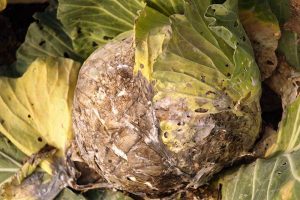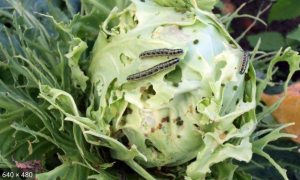Ring rot

This one amongst many diseases facing cabbage farming in Kenya. The leaves exhibit small, round ring-like brown greyish spots bordered by green margin. The fungus is spread by manure, wind and infected crop debris. Severe infestation may cause leaves to dry up and curl inwards. It requires cool, moist conditions to thrive. It is caused by a fungus known as Mycosphaerella brassicicola.
How to control ring rot
Plant certified seeds or disease- free seedlings. Clean and sanitize farm implements. Practice crop rotation for at least 2 years. Apply fungicide as per instructions.
Turnip Mosaic Virus
It can infect at seedling or vegetative stage and affects leaves and stems. In addition, it can develop during storage. Symptoms on young plants include lesions on leaves, mottling followed by systemic vein clearing, mosaic, leaf distortion and stunting. The stems will discolor, grow abnormally and dieback. The whole plant eventually dies. The disease is spread by aphids or mechanically.
How to control TuMV
Remove and destroy infected plant debris and infected plants. Alternatively plough in the fields the debris immediately after harvest. Maintain field hygiene. Plant resistant cultivars. Control aphids.
Bacterial soft rot
A soil borne disease caused by the bacteria Pectobacterium that thrives during high temperatures. It spreads when rain water splashes on lower leaves. The head becomes soft, rotten with a foul smell. Similarly, a foul smell is produced when the stem is cut. This is one of the challenges facing cabbage farming in Kenya.
How to control bacterial soft rot
Plant on raised beds for proper drainage. Practice crop rotation at least for 3 years with cereals. Weed to maintain field hygiene. Harvest during dry season. Harvest disease-free cabbage heads first and store in cool, well aerated facility. Remove and destroy infected plants and debris. Apply copper- based fungicide as per instructions.
Leaf spot
It is a soil-borne fungi which is common during hot weather. It is spread by water, wind or farm tools. Dark brown spots appear on leaves that later form into holes. The leaves eventually dry up.
How to control leaf spot
Use certified seeds. Practice crop rotation. Apply fungicide as per instructions.
Black rot
It is caused by the bacterium Xanthomonas campestris. The bacteria survive in the soil and thrives during humid temperatures with the soil temperature also high. In the early stages of infestation, the symptoms include yellow brown leaf margins. Later the spots turn black, soft and rot producing bad smell.
How to control black rot
Plant certified and disease resistant seeds. Grow cabbage on raised beds with mulching. . Remove and destroy infected plants residues. Plough infected debris immediately after harvesting. Apply bactericide as per instructions.
Club Root
The fungus, Plasmodiophra brassicae causes extensive galling, swelling and distortion of the roots. It enters the root hairs forming large club-like galls affecting roots functions. A water mold, it can survive in the soil for long after infecting the crop. Infected plant wilt on hot days and recover later when the sun goes down. Seedlings die and if they survive they experience stunted growth. It can be spread by irrigation water and farm tools.
How to control club root
There is no effective control once the plant is infected. Practice crop rotation. Maintain field hygiene. Check pH by soil testing. Apply lime to create unfavorable condition in the soil for spore formation.
Damping-off
It mostly occurs at nursery stage in the seed bed. The fungal disease is prevalent during rainy season due to too much moisture. The seedlings rot at the base of the stem causing it to fall over.
How to control damping-off
Plant certified disease -free seeds. Provide proper spacing by avoiding dense sowing. Avoid excessive watering and fertilization. Practice crop rotation. Apply fungicide appropriately and as per instructions.
Black Leg
It is caused by a fungus, Phoma lingam and damage the roots. The seedlings develop pale, irregular spots on the leaves or stems which later become oval or circular with gray centers. Eventually they spread on the underside of the leaves. Dark cankers extend from stem to the roots killing the root system. In severe infestation, the plant will be stunted, wilt and die. It can be spread by splashing water from irrigation or rain, wind and farm tools.
How to control black leg
Plant certified seeds. Maintain field hygiene. Practice crop rotation for 1-2 years. Ensure proper drainage. Infected plants should not be fed to animals if the waste is to be used as manure. Apply fungicide on base of plant (as per instructions).
Bottom rot
The soil-borne fungus Rhizoctonia solani is contracted from contaminated soil. Brown or tan lesions appear on the outer leaves. This occurs mostly when the leaves and soil are wet and temperatures are 68-82 degrees fahrenheit.
How to control bottom rot
There are no controls once the plant is infected. However, plant on raised beds for proper drainage. Keep plants healthy by proper feeding.
Cottony rot
It is caused by a fungus Sclerotinia sclerotiorum. It can survive on living plants, infected tissues and in the soil. The fungus affects young and mature plants in the field and in storage. The symptoms include tan, water-soaked, circular areas, covered by white cottony fungal growth with the host tissue becoming soft and watery. Subsequently large black structures appear on dead tissue. Plant wilt and dies as a result of root infection.
How to control cottony rot
Plant in well-drained soil. Ensure proper spacing for aeration. Practice crop rotation with maize for 3 years.
Powdery Mildew
It is a fungal disease exhibiting white, powdery spots that may appear on both sides of leaves and stems. The spots grow in size as the leaves gradually turn yellow, die and fall off exposing the cabbage head to sunburn. The fungus is known as Erysiphe polygoni.
How to control powdery mildew
Provide proper spacing for sun penetration and aeration. Wash off spores by spraying or sprinkling water. Plant disease resistant cultivars. Remove and destroy crop debris after harvesting.
Downey Mildew
Downy Mildew is caused by a fungus Peronospora parasitica, a water mold. The disease thrives in cool, moist weather conditions. Lesions appear on the upper side of the leaves with gray masses of spores on the underside of the leaves. Eventually the leaves yellow and fall out. It spreads by wind and rain splash.
How to control downy mildew
Plant disease-free seedlings. Maintain field hygiene. Ensure proper spacing for aeration. Plan to plant during cool weather and harvest during dry weather. Apply fungicides as per instructions. Practice crop rotation for 2-3 years. Plough infield crop debris immediately after harvest.
Yellows
It is caused by Fusarium oxysporum that live in the soil for a long time. It prefers warm temperatures. The leaves of the plant appear dull and yellowish and may die early. The surviving leaves are stunted.
How to control yellows
Plant resistant varieties.
Black Diamond Moths
They feed on leaves causing defoliation which may lead to a total loss of crop. In addition, they make holes and tunnels on cabbage heads.
How to control DBM
Plant trap crops such as mustard every 15 rows of crucifers to attract DBM. Monitor trap crops regularly to control DBM from moving to main crop (cabbages). Use botanical pesticides e.g. by grinding 200g of dried and shelled neem seeds. Soak overnight in 4 liters of water. Chop 12 pieces of hot chilies and mix. Strain. Apply chemical insecticide as per instructions.
Aphids
One of the indications of aphid infestation is the appearance of sooty mold on the plants. This is as a result of the honeydew produced by aphids that turns leaves and branches black. Aphids pierce plant tissues to suck the sap leaving the plants distorted, stunted, yellow and eventually wilt.
How to control aphids
Destroy and expose the colonies, eggs and larvae to natural predators and sunlight by cultivating and flooding the field. Aphids enjoy feeding on soft juicy leaves hence the need to apply soluble nitrogen fertilizers as per instructions. Avoid excessive doses. Practice intercropping with garlic, coriander, onions. Maintain field hygiene. Allow for natural aphid predators like lady birds. Spray plants with water to knock aphids from plants. Monitor and scout for aphids early in the season, mostly the underside of the leaves. Use sticky board traps. Spray soap solutions (ammonia spray) as per instructions. Apply botanical pesticides e.g. by mixing ginger 50g with 3 liters of water and 12ml of soap. Another option is to boil 500g of custard apple leaves in 2 liters of water. Stop the boiling with the water at 0.5 liters. Dilute and filter with 10-15 liters of water.
Cutworms

The caterpillars usually attack the plants at the early stages of growth. Cutworms eat during the night and cut the stems at the ground level causing them to fall. The young ones eat the soft leave while the fully grown can eat the whole plant. They can be found in the soil near the plant.
How to control cutworms
Practice interplanting with onions, peppermint, garlic, coriander. Allow for natural predators. Apply botanical pesticides. Grind 50g of basil leaves and overnight in 3 liters of water. Add and stir well in 12 liters of water. Spray chemical insecticide as per instructions.
Whiteflies
They are small white insects always found underneath the leaves of the plant. They suck juice from the plant.
Allow for natural predators such as ladybird beetles, mites. Avoid high doses of nitrogen fertilizer. Apply mineral oils and neem. Spray soapy water solutions.
Thrips
A cabbage is as good as its head. A large, round and compact cabbage head gives a head start in the market. Farmers are advised to source seeds from registered stockist

